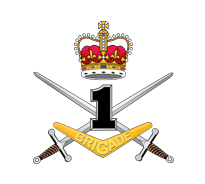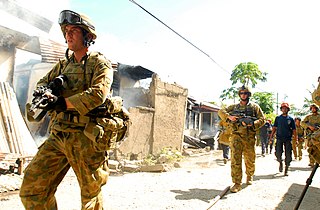
1st Armoured Regiment is an armoured regiment of the Australian Army and is the senior regiment of the Royal Australian Armoured Corps. Formed as a tank unit in the new Australian Regular Army on 7 July 1949, the regiment subsequently saw service during the Vietnam War operating Centurion tanks. Currently the unit is based in Edinburgh, South Australia as part of the 9th Brigade. As part of the Plan Beersheba reorganisation, the unit has become one of three Armoured Cavalry Regiments (ACRs) assigned to the Army's multirole combat brigades in Brisbane, Darwin and Townsville. Each ACR is equipped with M1A1 tanks and ASLAV light armoured vehicles.

This article describes the current structure of the Australian Army. It includes the army's order of battle and the headquarters locations of major units. Members of the Australian Army also serve within joint units of the Australian Defence Force which fall outside the direct command of the Australian Army.

6th Battalion, Royal Australian Regiment is a mechanised infantry battalion of the Australian Army. It was originally raised in Brisbane, Queensland, on 6 June 1965 and has since then served in a number of overseas deployments and conflicts including South Vietnam, East Timor, Iraq and Afghanistan. During the Vietnam War, the battalion earned a US Presidential Unit Citation from the United States when members from 'D' Company participated in the Battle of Long Tan on 18–19 August 1966. The battalion is currently based at Gallipoli Barracks in Brisbane and forms part of the 7th Brigade.

1st Brigade is a combined arms formation of the Australian Army. Formed in 1903 as a militia formation based in New South Wales, it was reconstituted as part of the Australian Imperial Force in 1914 for service during World War I, the brigade fought at Gallipoli and on the Western Front before being disbanded in mid-1919. In 1921, the 1st Brigade was re-raised as a unit of Australia's part-time military forces, based in New South Wales. During World War II the brigade undertook defensive duties before being disbanded. In 1948, it was re-raised as an integral part of the Australian Regular Army. Currently the brigade is based at Robertson Barracks in Darwin and at RAAF Base Edinburgh near Adelaide, South Australia. It is the first of the Australian Army brigades to be re-organised as a combat brigade under Plan Beersheba.

The Special Operations Engineer Regiment (SOER) is a specialised unit of the Australian Army. The regiment forms part of the Special Operations Command. The unit was formed in 2002 as the Incident Response Regiment (IRR), they are deployed to respond to chemical, biological, radiological, nuclear or explosive incidents. The regiment was transferred into the newly raised Special Operations Command in 2003. In 2010 and 2011, its role changed to supporting the army's special forces units, and it was renamed accordingly.

The 3rd Brigade is a combined arms brigade of the Australian Army, principally made up of the 1st and 3rd Battalions of the Royal Australian Regiment. Initially raised in 1903 as part of the post-Federation Australian Army, it was removed from the order of battle in 1906 following the restructure of the field force. It was re-formed in 1914 for service during World War I, taking part in the fighting at Gallipoli and on the Western Front in Europe. During World War II the brigade was used in a defensive role before it was disbanded in 1944. It was re-raised in 1967 for service during the Vietnam War and later went on to provide the nucleus of the deployment to East Timor during the Australian-led intervention in 1999. The brigade is currently based at Lavarack Barracks in Townsville, Queensland.

The 5th/7th Battalion, The Royal Australian Regiment (Mechanised) was a mechanised infantry battalion of the Australian Army. The battalion was based at Robertson Barracks in Holtze, Northern Territory and formed part of the 1st Brigade. It was formed in 1973 by linking both the 5th and 7th Battalions of the Royal Australian Regiment together and was disbanded 3 December 2006, as part of the expansion of the Australian Army, when the 5th and 7th Battalions of the Royal Australian Regiment were delinked into two separate battalions once again.

The 3rd Battalion, Royal Australian Regiment is a mechanised infantry battalion of the Australian Army, based in Kapyong Lines, Townsville as part of the 3rd Brigade. 3 RAR traces its lineage to 1945 and has seen operational service in Japan, Korea, Malaya, Borneo, South Vietnam, Rifle Company Butterworth, East Timor, the Solomon Islands, Afghanistan and Iraq.

Robertson Barracks is a major Australian Army base located in the Northern Territory of Australia within the suburb of Holtze in the Municipality of Litchfield about 15 kilometres east of the Darwin city centre. The barracks were built during the 1990s. The Barracks are home to the 1st Brigade and the 1st Aviation Regiment. Robertson Barracks has a helicopter airfield, similar to Holsworthy Barracks. The barracks was named after Lieutenant General Sir Horace Robertson, commander of the 1st Armoured Division and 6th Division during the Second World War, and later Commander in Chief British Commonwealth Occupation Force in Japan.

Operation Astute was an Australian-led military deployment to East Timor to quell unrest and return stability in the 2006 East Timor crisis. It was headed by Brigadier Bill Sowry, and commenced on 25 May 2006 under the command of Brigadier Michael Slater. The operation was established at the request of East Timor's government, and continued under an understanding reached between Australia, East Timor, and the United Nations, with the United Nations Integrated Mission in East Timor supporting and helping to develop East Timor's police force. Other countries deploying soldiers to East Timor include Malaysia, New Zealand and East Timor's former colonial power Portugal, operating under independent command.

The 8th/9th Battalion, Royal Australian Regiment is a motorised infantry battalion of the Australian Army. It was originally formed in 1973 by linking together both the 8th and 9th Battalions of the Royal Australian Regiment. Over the next twenty-four years the battalion would remain on the Australian Order of Battle based at Enoggera Barracks in Brisbane, Queensland, until it was disbanded in 1997 amid a number of Defence-wide cutbacks introduced by the Howard government. In 2006 it was announced that the battalion would be re-raised as part of a plan to expand the size of the Army and since then it established itself as a fully deployable motorised infantry battalion as part of 7th Brigade.

The 5th Battalion, Royal Australian Regiment is a regular motorised infantry battalion of the Australian Army. Originally established in 1965 it would serve two tours of South Vietnam before it was linked with the 7th Battalion to form the 5th/7th Battalion, Royal Australian Regiment in 1973. In late 2006 the two units were de-linked, and 5 RAR again joined the Australian Army's order of battle in its own right. It has since served in Iraq, East Timor and Afghanistan.
The ANZAC Battle Group was an Australian-led battle group deployed to Timor Leste as part of Operation Astute. The battle group was established in September 2006 and comprised several rifle companies, including a company from the New Zealand Army, and sub-units of other Australian Army units.
The 2nd Combat Engineer Regiment (2 CER) is an Australian Army combat engineer regiment located at Gallipoli Barracks in Brisbane, Queensland. It is part of the Australian 7th Brigade, attached to Forces Command (Australia).
5th Engineer Regiment is a Reserve unit of the Royal Australian Engineers. Originally raised as the "5th Combat Engineer Regiment" in 1995 from the 4th Field Engineer Regiment, it is based in Holsworthy, Sydney, with one of its sub-units based at the multi-user depot HMAS Harman, in Canberra and another at Orchard Hills in western Sydney. Some of the unit's subunits draw lineage from the 4th and 5th Field Companies, which were raised for service during World War I.

Operation Toan Thang I was a U.S. Army, Army of the Republic of Vietnam (ARVN), 1st Australian Task Force and Royal Thai Volunteer Regiment operation conducted between 8 April and 31 May 1968 in the Vietnam War. The operation was part of a reaction to the Tet Offensive designed to put pressure on Vietcong (VC) and People's Army of Vietnam (PAVN) forces in III Corps.
4th Combat Engineer Regiment was an Australian Army Reserve engineer regiment based at East Ringwood, Victoria. Raised on 1 July 1995, upon formation, the regiment consisted of the 10th and 35th Field Squadrons and the 38th Support Squadron. It is an Army Reserve unit that provides engineering support to the 4th Brigade, and played a pivotal role in the ADF support to the 2003 Victorian Alpine Fires and the 2009 Black Saturday Fires. Throughout 2009, the regiment also contributed personnel to operations overseas, including deployments to Afghanistan and the Sinai; other personnel took part were detached to Rifle Company Butterworth and Operation Resolute. In 2013, 4 CER merged with the 22nd Construction Regiment, to form the 22nd Engineer Regiment.

The 21st Construction Regiment was a construction engineer regiment of the Australian Army Reserve. Part of the 5th Brigade, the regiment was formed in 1950 and was based in New South Wales where it provided support to the 2nd Division. The regiment has contributed personnel to a number of operations including the Regional Assistance Mission to the Solomon Islands, Operation Slipper and Operation Astute. It also regularly supported the Army Aboriginal Community Assistance Program and provided assistance to the Australian community in times of natural disaster. The regiment was disbanded in 2013.
The 8th Engineer Regiment was a reserve engineer regiment of the Australian Army. Originally raised as the "8th Combat Engineer Regiment" in 1995, the unit provided support during the 2000 Sydney Olympics and the APEC Australia 2007, and was headquartered at Bullecourt Barracks, Adamstown, New South Wales, where it formed part of the 8th Brigade.
The 11th Engineer Regiment(11ER) is an Australian Army Reserve engineer regiment trained for sapper/combat engineer and construction engineer operations. While 11 ER was formed on 1 January 2014 as a result of recent Australian Army modernisation efforts, 11 ER's lineage is traced back to early Queensland volunteer engineer units as early as 1879. In 1916, 11th Field Company was formed and during World War I, this unit was renowned for action during the Battle of the Somme and the Hindenburg Line. During World War II, it fought the Japanese during the Kokoda Track campaign and on Bougainville Island. The Regiment's Headquarters is located at Gallipoli Barracks in Brisbane, Queensland with subunits located across Queensland. 11ER is part of 11th Brigade, attached to Forces Command.













